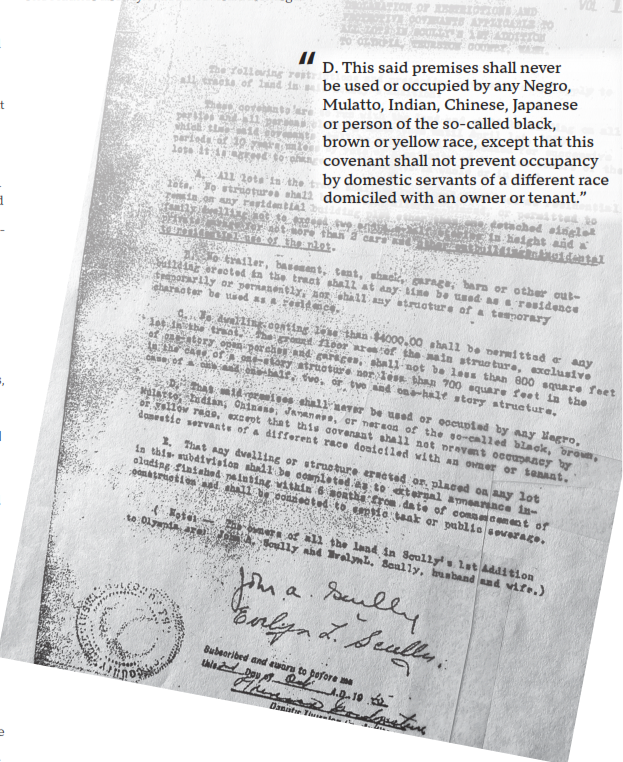How the past created the present
At one point in America’s history state and federal policies were designed to encourage families to own their own home.
But not all families
New Deal policies subsidizing homeownership explicitly excluded non-white families, guaranteeing the creation of segregated communities that endured for generations. Combined with restrictive covenants, redlining, denial of credit, displacement and other measures, these policies and practices robbed African American and other nonwhite families of the wealth they could have accumulated as homeowners.
Without these explicit and implicit actions to keep some Americans from participating fully in the economy, the country would have looked very different today.
The role of Washington state
This session, the WA legislature recognized that the state government was “both an active and passive participant” in promoting measures designed to keep people from access to homeownership solely because of their race.
They focused on the presence of the racially restrictive covenants prevalent in many cities and towns in Washington. These “covenants” were written into property deeds and were legally enforceable on successive owners, until outlawed in 1948. Despite being illegal, they persisted through the late 1960s when the Fair Housing Act was passed.
Keeping parts of Thurston County white
In Thurston County, according to the Auditor’s Office, there are several neighborhoods where such racial restrictions were in place for years: Beachcrest, Lake St Clair Summer Home Tracts, Scotts, Scully’s First Addition, Stratford Park, and Stratford Park Place and Annex.
Here is the restrictive provision from a deed in Scully’s First Addition:
This said premises shall never be used or occupied by any Negro, Mulatto, Indian, Chinese, Japanese or person of the so-called black, brown or yellow race, except that this covenant shall not prevent occupancy by domestic servants of a different race domiciled with an owner or tenant. (A section of the actual deed is on this page.)

Plat maps for these neighborhoods, showing all properties where the covenant applied, are available online through the Auditor’s Office. (The Auditor will also provide landowners with a document to strike the language from an existing deed.)
HB 1474—The Covenant Homeowners Account
While presented as a remedy for the destructive effects of restrictive covenants that continue to exist in the present day, HB 1474 is itself very restricted. Its centerpiece is a “special purpose credit program” that will loan “qualifying first-time home buyers” money to assist with down-payment and closing costs. The loan must be repaid when the house is sold.
A “qualifying first-time home buyer” must have an income below 100% of the area median; be a resident of Washington (or their descendant) who resided here prior to April 1968, and who was or would have been excluded from buying a home because of a racially restricted covenant.
Creating the program
The legislature created a new funding source for the program. Beginning in January 2024, county Auditors will add a $100 surcharge to the fee for recording documents (with certain exceptions). The Auditor already collects several surcharges imposed by earlier legislation so the new surcharge will bump up the total to about $300 per document.
The program won’t begin to operate until the Washington State Housing Finance Commission completes a study that documents past discrimination and the effect of existing remedies, and makes recommendations about how the loan program should be structured and run. The study is due in March of 2024.
Bethany Weidner writes often for Works in Progress and was the beneficiary of the Homestead Act when her parents settled in Alaska in 1949.
Sources:
- www.thestand.org/2022/03/wash-connections-academy-staff-joining-together-with-seiu-925/
- www.facebook.com/watch/?v=1351669185337972
- www1.salary.com/K12-INC-Executive-Salaries.html
- www.theguardian.com/business/2020/sep/18/third-of-pearsons-shareholders-vote-against-ceos-72m-pay-package
- www.zippia.com/connections-academy-careers-20002/salary/
- www.zippia.com/k12-careers-6429/
- www.indeed.com/cmp/Connections-Academy/reviews
- nces.ed.gov/surveys/ntps/tables/ntps1718_fltable06_t1s.asp
- ofm.wa.gov/washington-data-research/statewide-data/washington-trends/budget-drivers/kindergarten-through-grade-12-k-12-enrollment
Be First to Comment